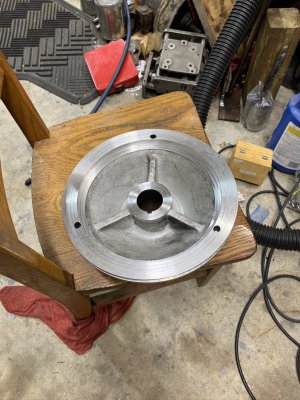When I bought the 1977 GMC motorhome the radio was shot and I replaced it with a current model 1-DIN in-dash unit.
After connecting it to the existing speakers it became obvious that one of them had been damaged as the sound was 'fuzzy'. So I acquired some JBL 3..5" 2- way units to replace the OEM equipment. Very limited space for the speakers in the first place and the new ones with their larger magnets and protruding tweeter meant the original bezel would not work.
Here's what the OEM looks like:

There's the speaker, a light and a switch for the light.
Removing the bezel revealed a very small speaker that was pretty marginal as far as frequency response and power handling was concerned, plus one of the speakers had obviously been subjected to water damage to the cone and probably warped the voice coil.
OEM and replacement speaker shown here.

Rear view comparing old and new - note larger magnet:

So now off to measure the original bezel and make something to replace it. Got an opportunity to use the Sorenson Center-Mike to locate the 4 mounting holes and started programming the mill to cut some poly-whatever plastic stock to an appropriate shape and size.

After a couple of iterations and test-fitting into the motorhome I came up with this:

And the finished product looks like this:

The thickness of the material (1/4") and putting the speaker on the inboard side allowed the magnet to fit behind quite nicely.
Wider view:

All in all, a mostly satisfactory outcome. Color doesn't match but works as an accent color like the window framing. First one took about 6 hours, #2 about 10 minutes start to finish.. Better sound (not great, what are we expecting from a 3 1/2" speaker?) Onward to the next project!
UPDATE:
After building the bezels for 3 1/2" speakers it was obvious that there was room for a slightly bigger speaker, going from 3.5' to 4" would give slightly better low frequency response. (specs say 75 Hz vs 90 Hz, every little bit helps).
So I ordered 4" speakers (JBL Boss 4020) and re-programmed the CNC for the larger opening and 4 mounting screw locations. The 4" speakers are slightly deeper than the 3.5" ones so a bit of 3/8" high density foam insulation between the new bezel and the coach headliner spaced them out and provided a bit more acoustical isolation for better low end response.
33% larger cone area definitely gives better acoustical performance and significantly less distortion than the waterlogged original speakers!
Photo shows comparison of two units. Almost looks like a 5" speaker might fit but that would significantly thin the web of the bezel and probably not a good thing in an automotive (vibrating / shaking) environment. Also a 5" is too deep to clear without interference with the coach body. Oh well.




















